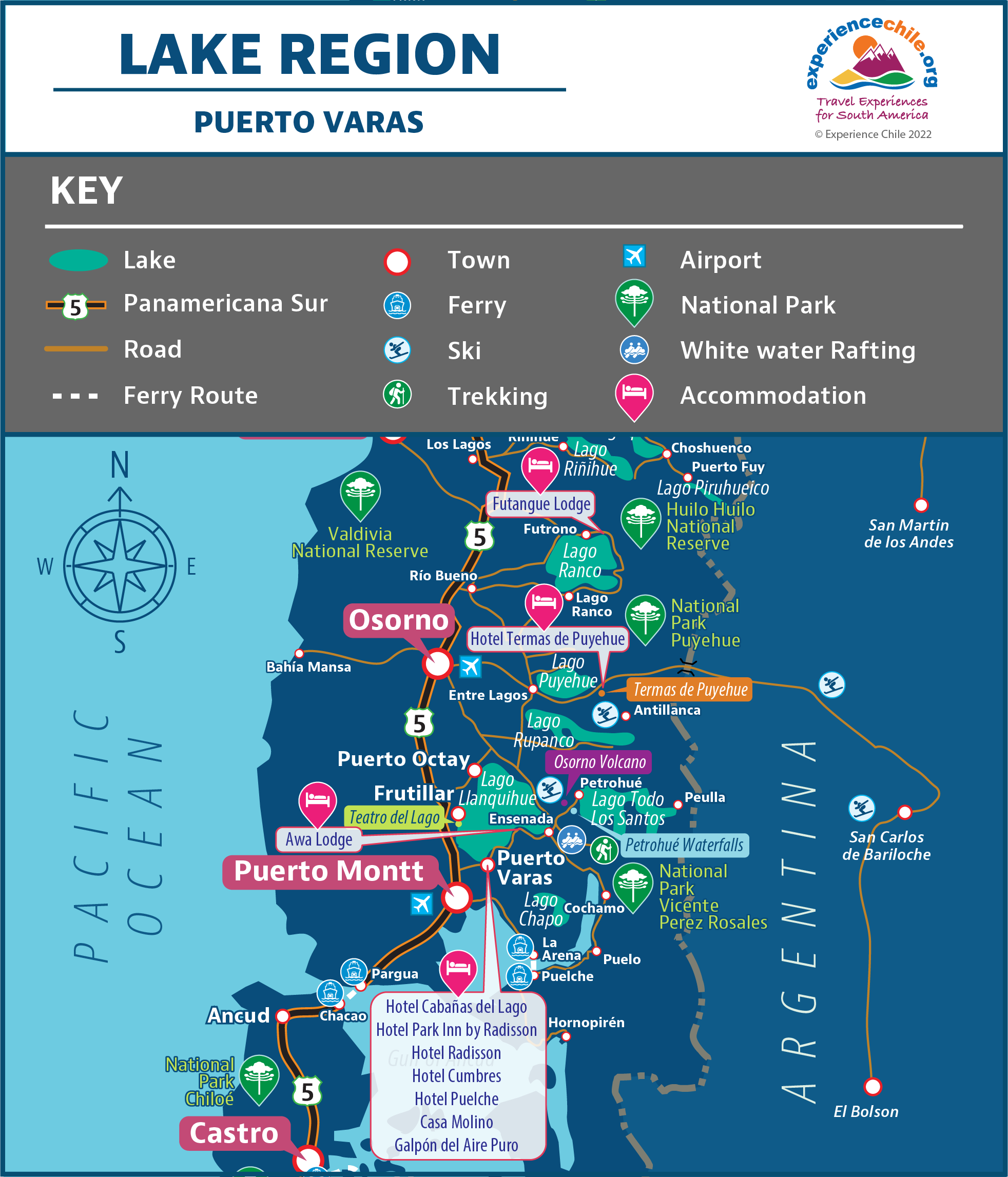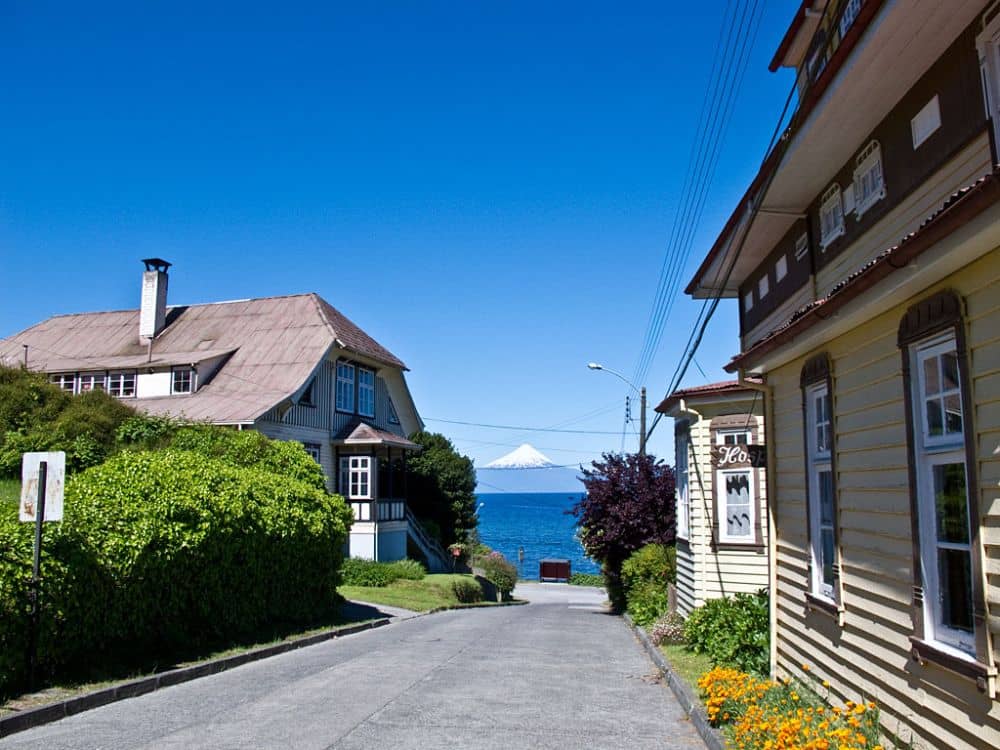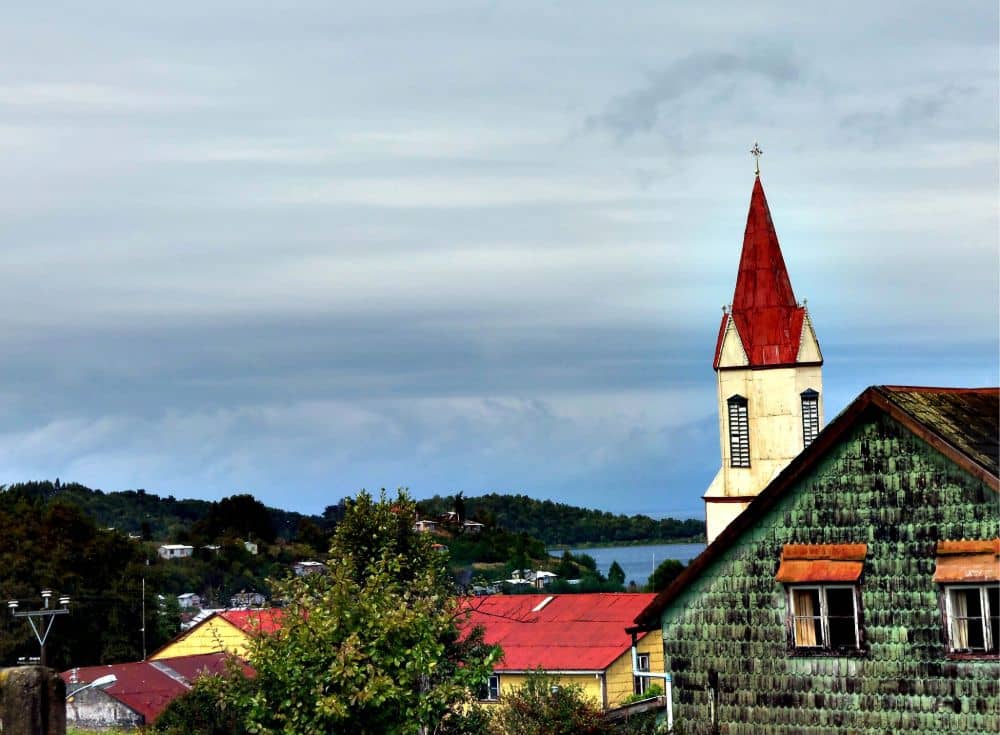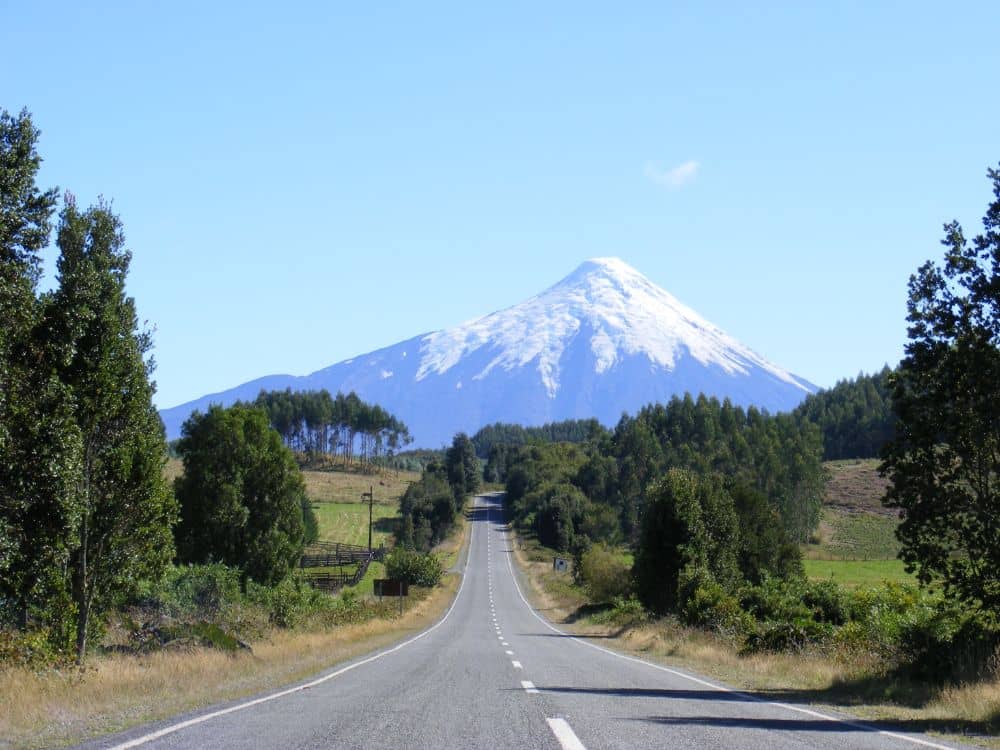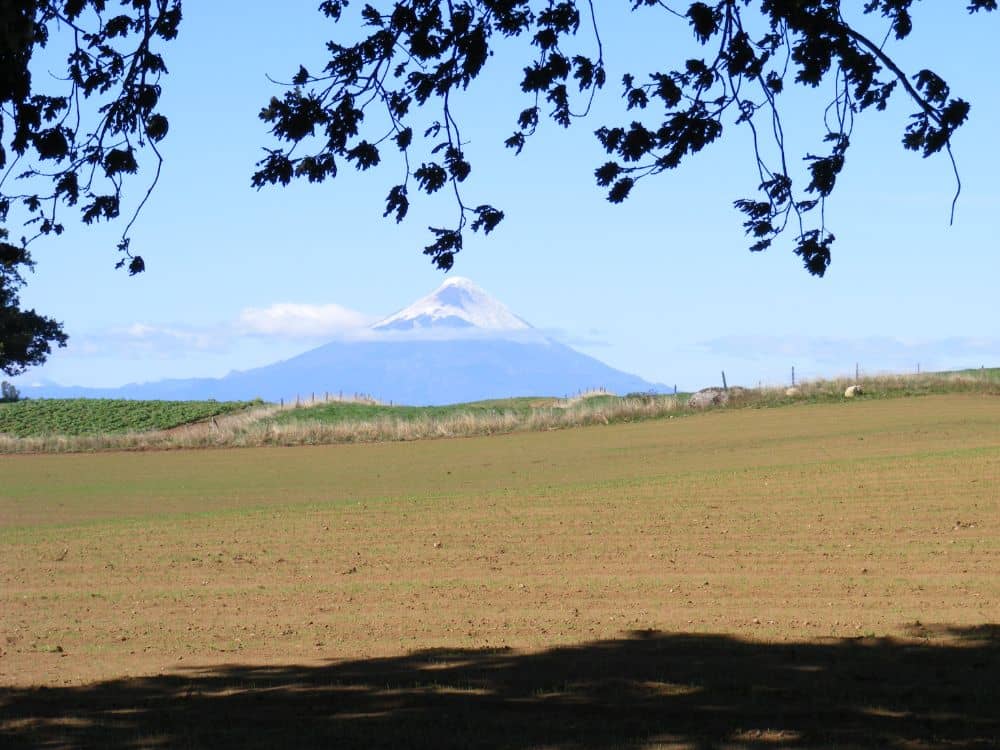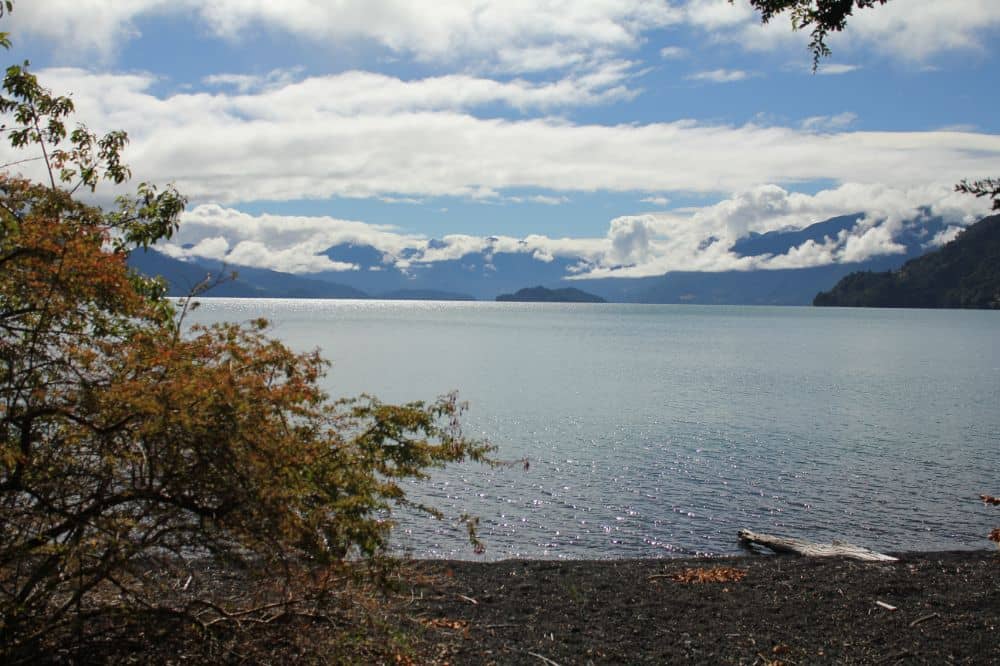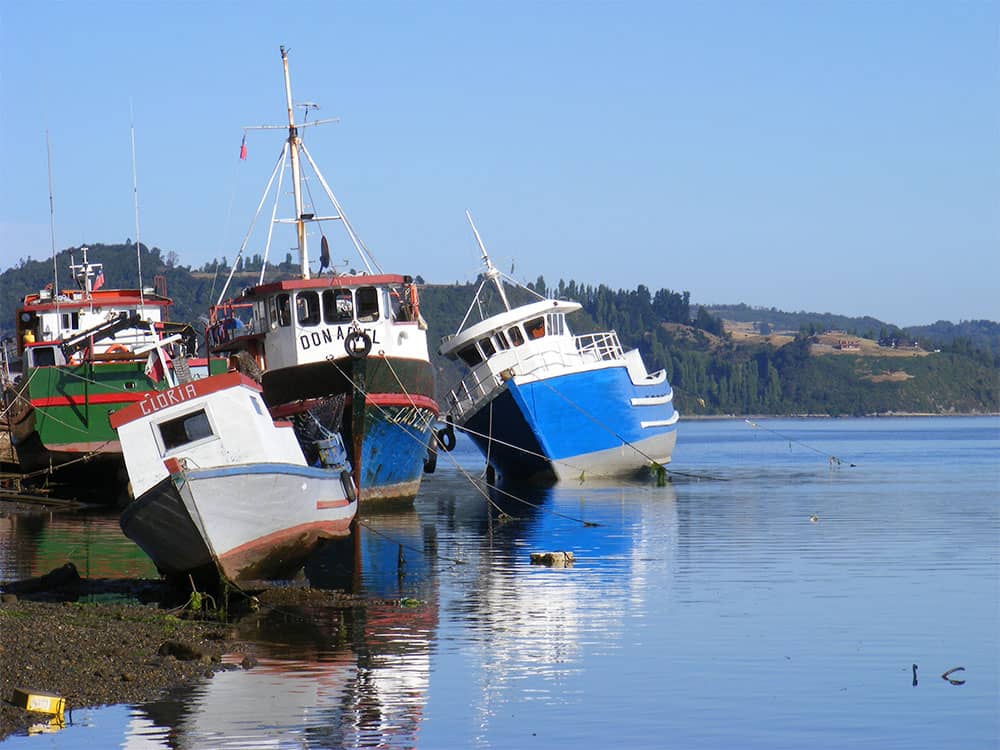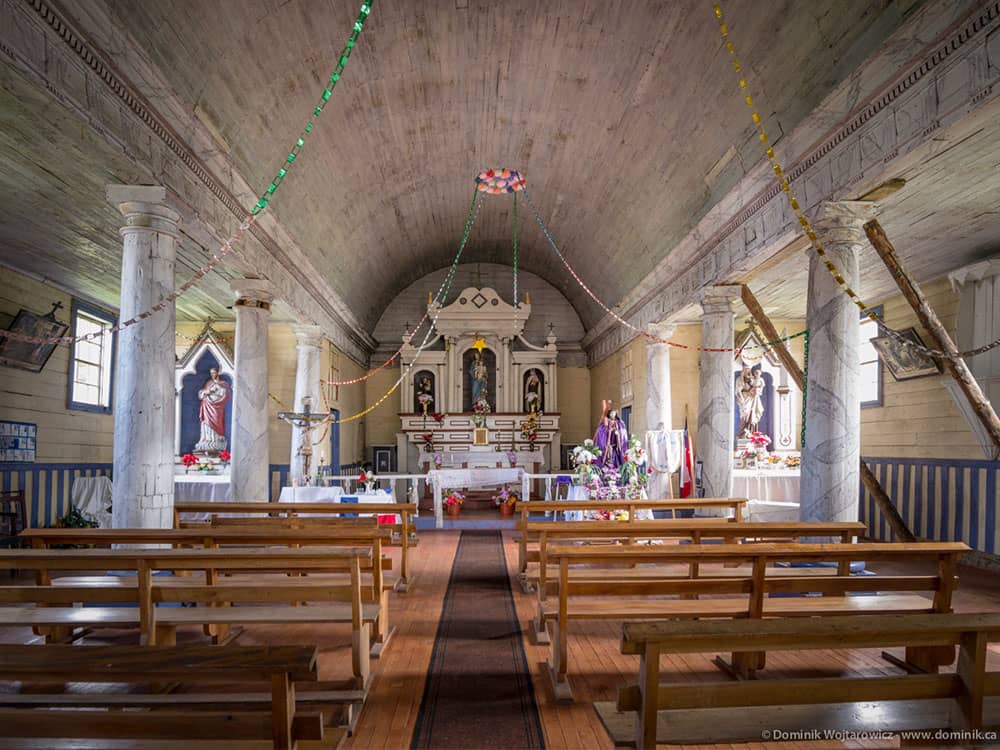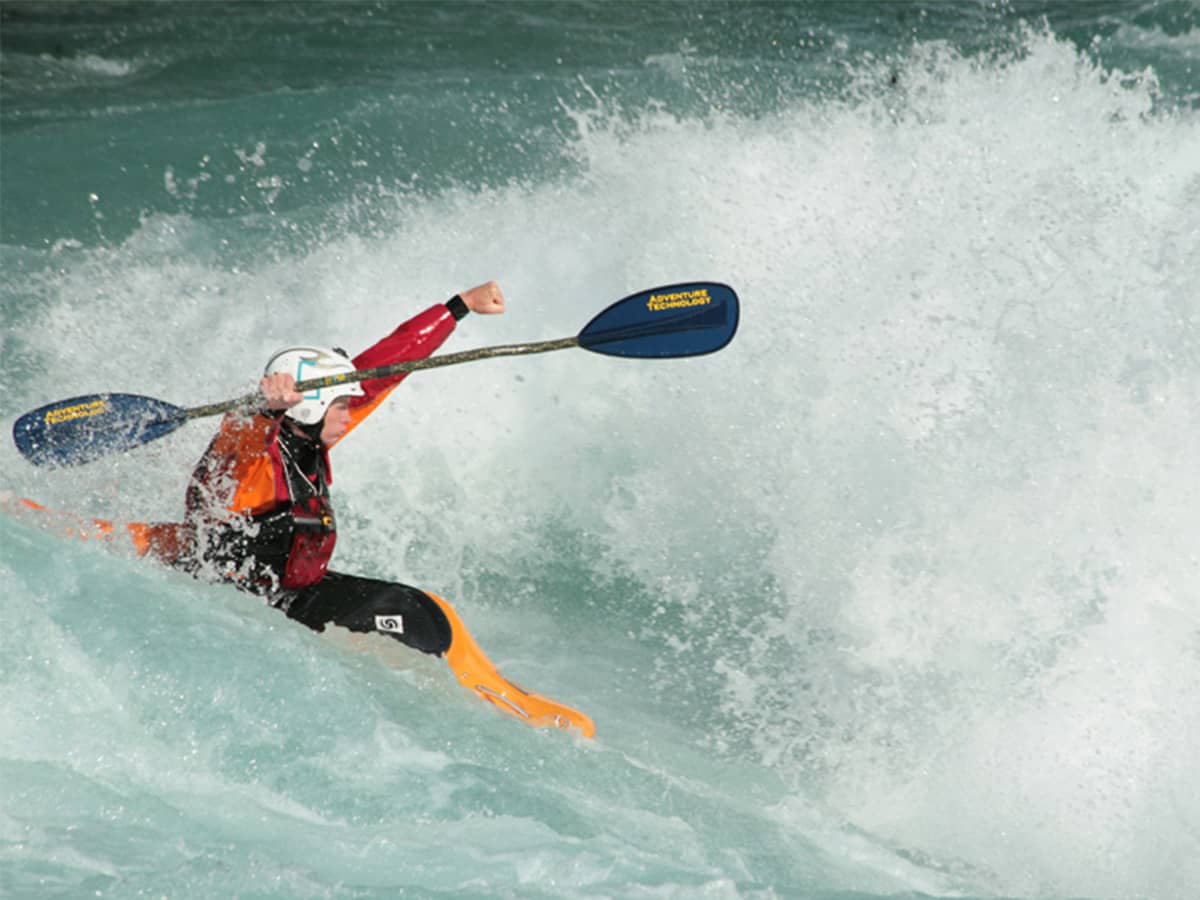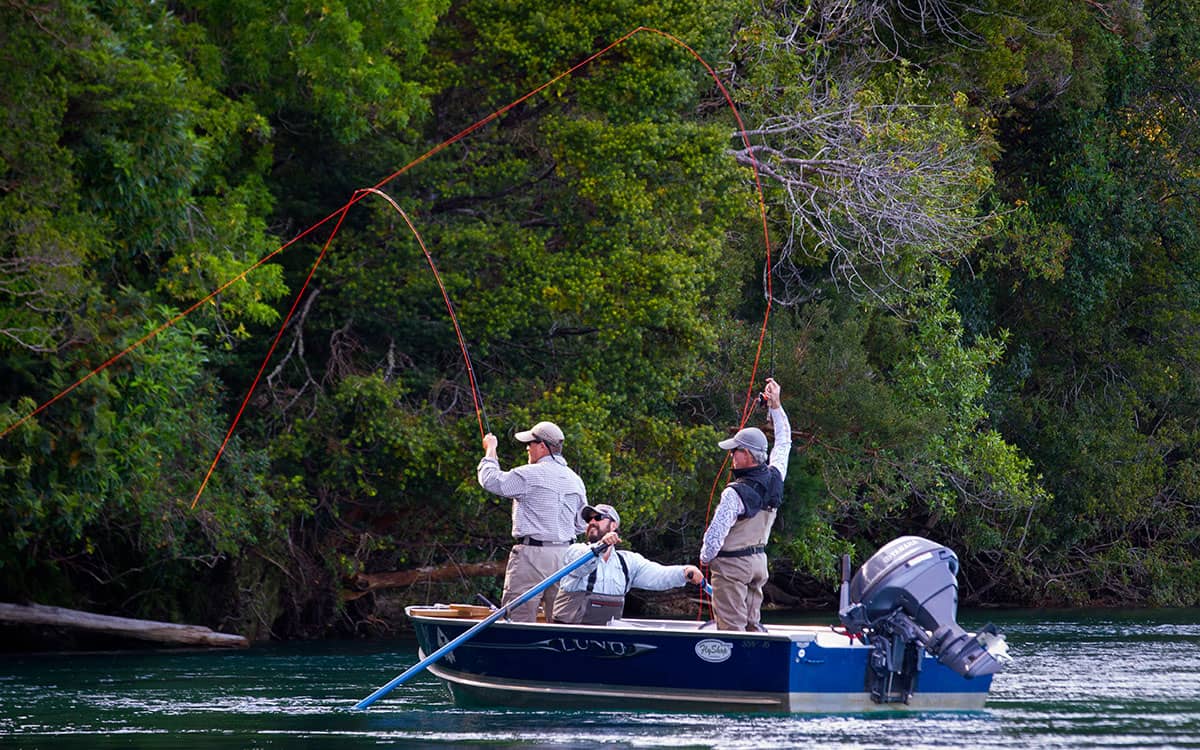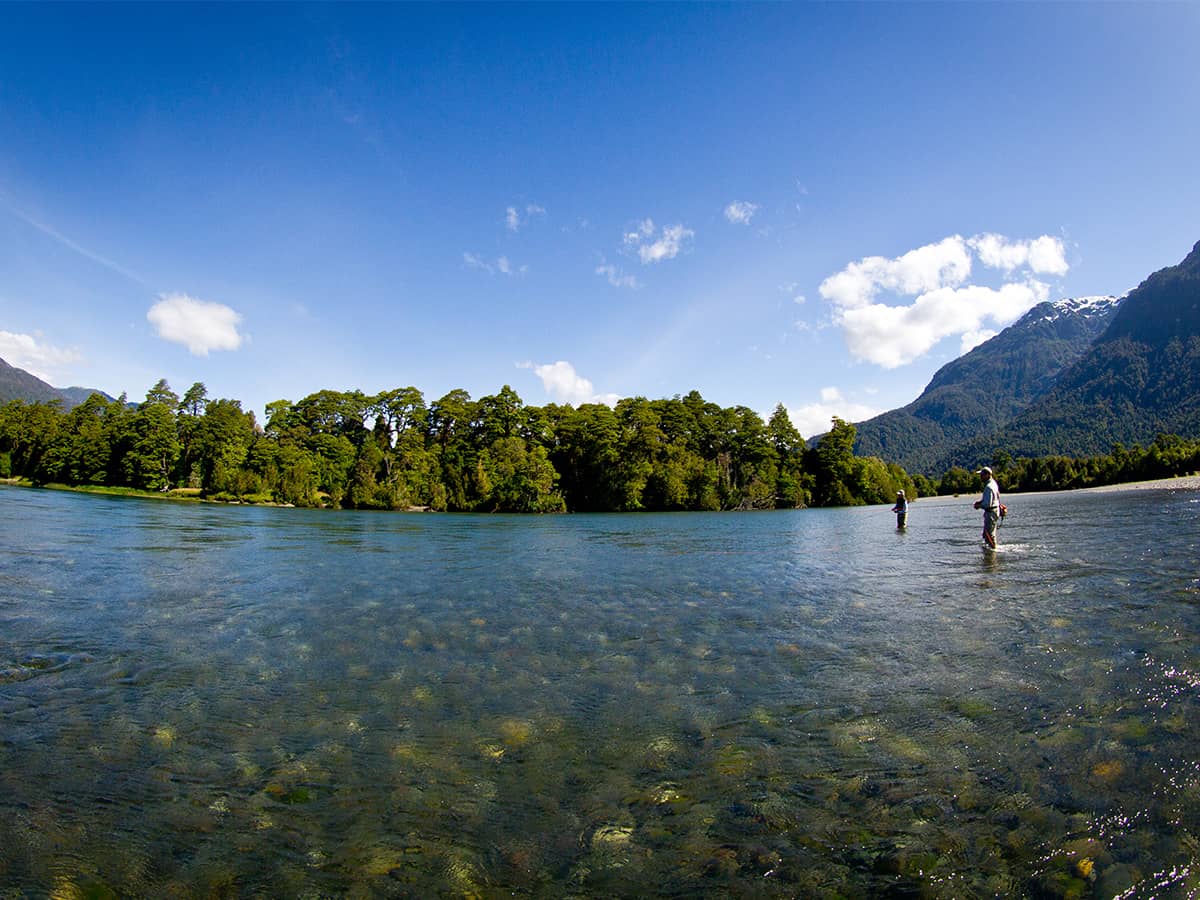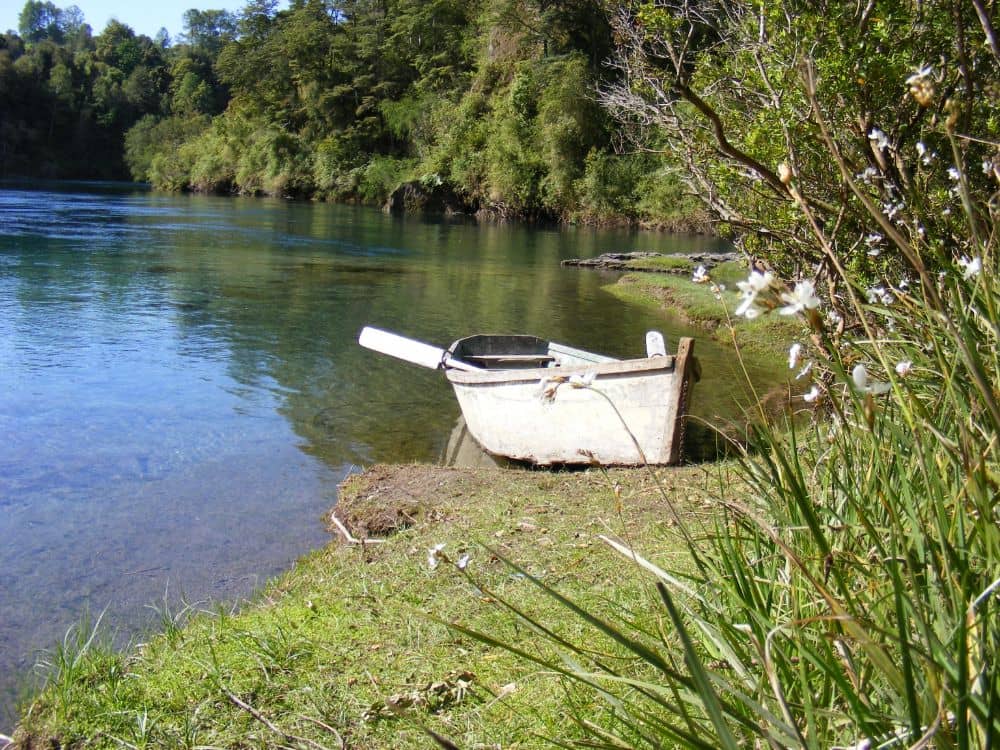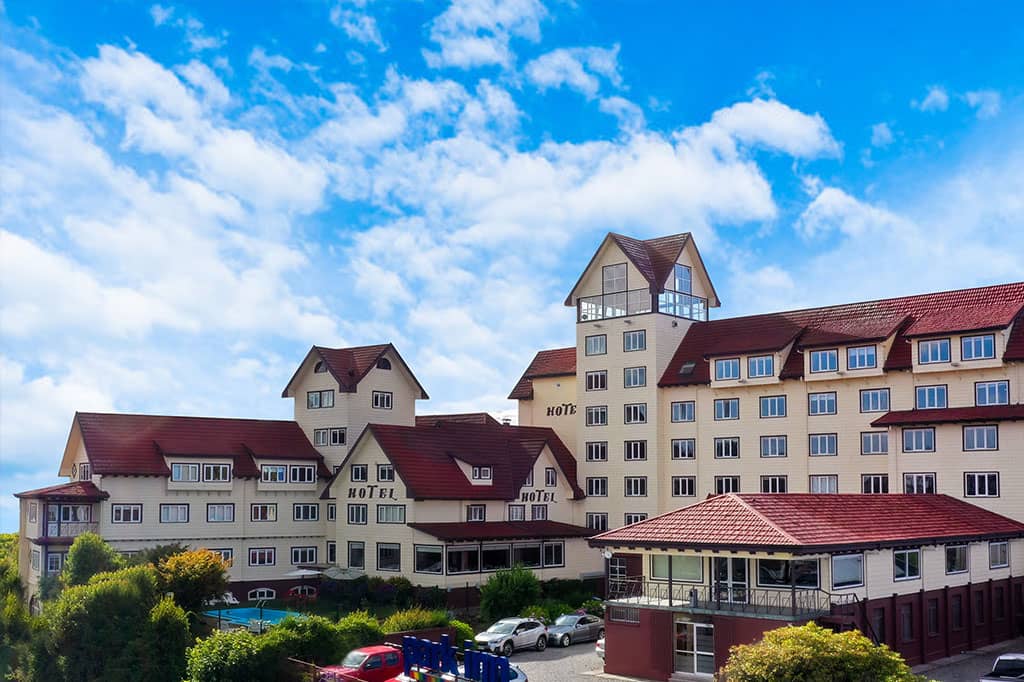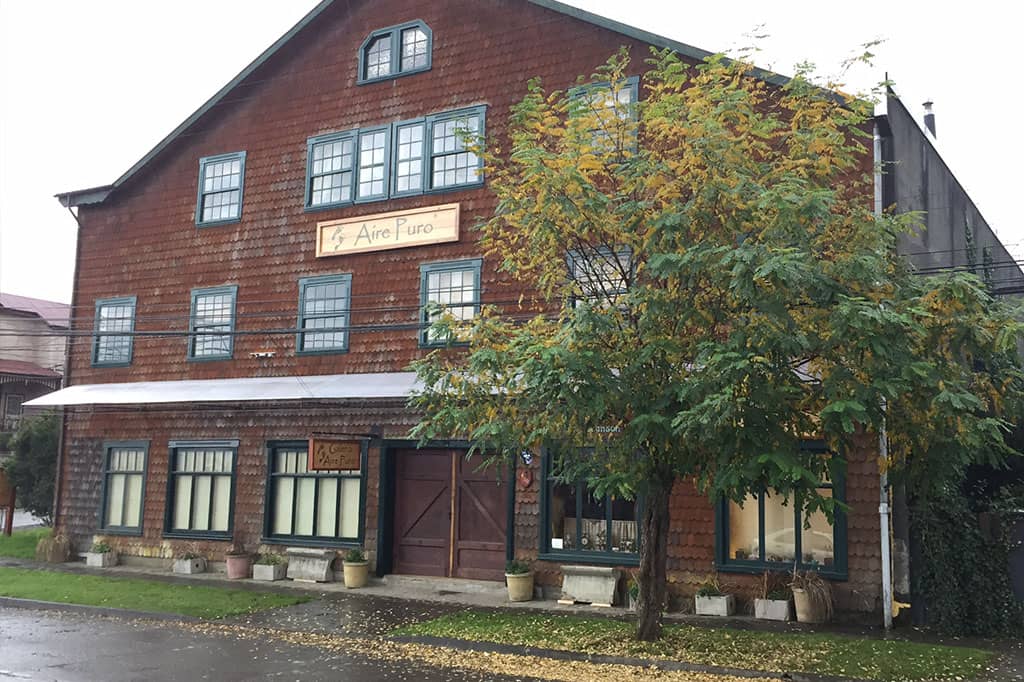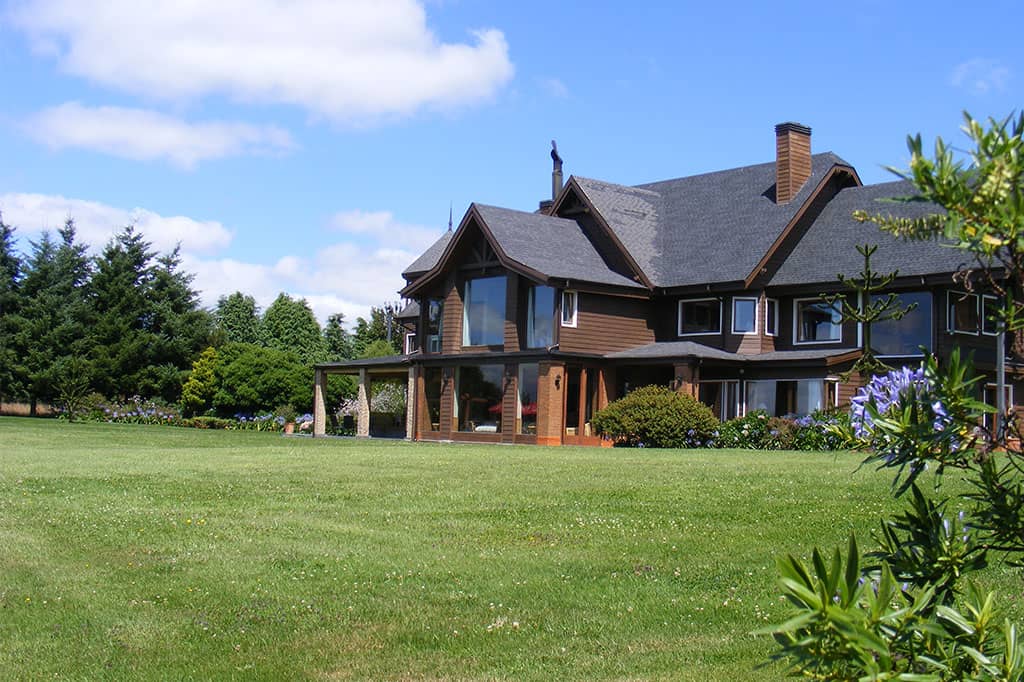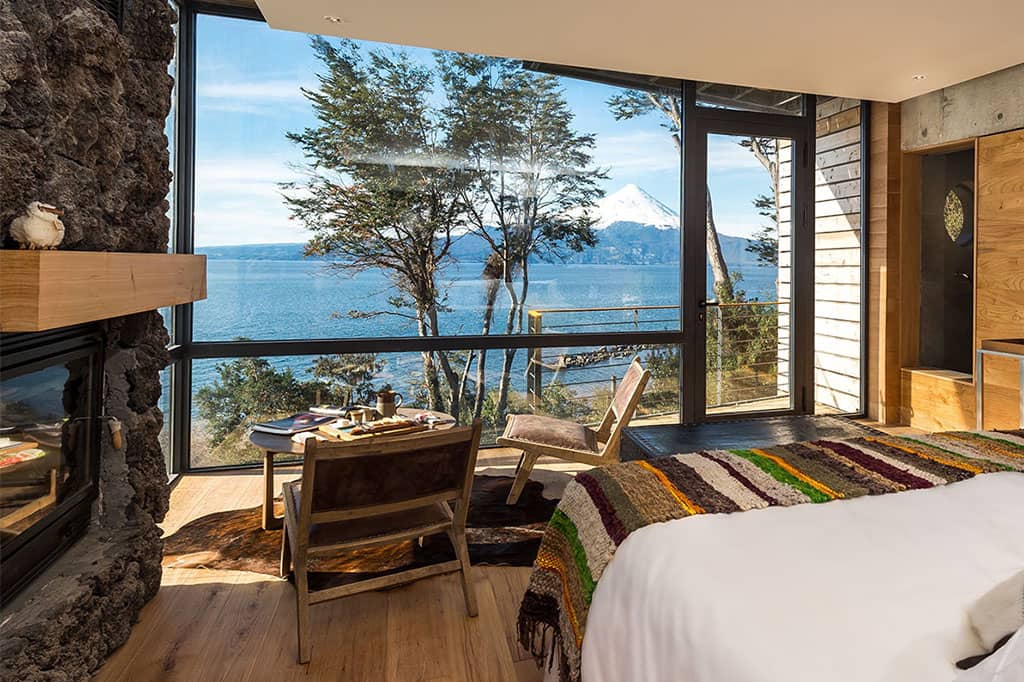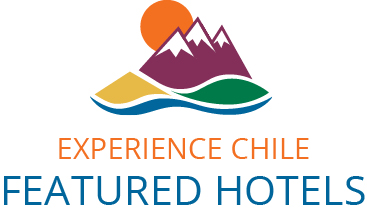Puerto Varas, Chilean Lake Region
Introduction
Puerto Varas has a village atmosphere and style, situated by the large Llanquihue (pronounced “yan-kee-way”) lake with direct views to the imposing snow-covered Osorno Volcano at the far, eastern end of the lake.
History
Puerto Varas is known as “the city of the roses”. It contains much of its original German architecture from 1852 when the village was founded by 212 German immigrant families who colonized the area. It was in February of 1852 when Perez Rosales, on the side of the Osorno Volcano, dictated that Puerto Varas would be founded at the location it is today.
It is a pretty lake-side village beside the largest lake totally in Chile, and the third largest in South America. From the village lake shore there is a direct view to the imposing, perfectly conical, snow topped Osorno volcano the other side of the lake, some 50km away.
For the visitor there is an option to circumnavigate the entire lake and visit the other, German-style settler villages such as Frutillar and Puerto Octay. In addition, or alternatively, there are scenic places such as the Lago Todo Los Santos, Petrohue Waterfalls and the Osorno Volcano to see.
About
Puerto Varas (996km south of Santiago) is located almost halfway between Frutillar (another lake-side village) and Puerto Montt (22km south of Puerto Varas), but it is a more active place than Frutillar and much larger too. The village has more of a Colorado Rockies Mountain style to it than anything typically Chilean, comprising a number of small, boutique-style stores and a few fishing shops as well as many wooden-clad buildings. However, there are also some modern hotels and a casino.
Similar to Pucon, Puerto Varas is a good base from where to enjoy many of the outdoor activities such as rafting, fishing, mountain biking and hiking.
Arrivals and Transfers
The nearest commercial airport to Puerto Varas is Puerto Montt, only about 25km from the village. Regular flights from Santiago take around 2.5hrs.
If driving from Pucón, the drive time is about 5hrs or so, which can be done via other lakes and through the country side, or using the faster Ruta 5 highway. If driving all the way from Santiago the distance is 996km and will take around 13hrs or so, allowing for stops.
ExperienceChile.Org offers a high-end, all-inclusive option here where the accommodation and food are "top-end" and excursions are accompanied with educated guides, or we can include other hotels, with stunning views to the lake, under a bed and breakfast program.
Places of Interest & Activities
Other villages to see include Frutillar and Puerto Octay, also located beside the lake and located further along the shore heading north from Puerto Varas. Places of “natural” interest are the Osorno Volcano, Petrohue waterfalls, National Park Vicente Perez Rosales, Lago Esmeralda (for its emerald-green colour). In addition, a full-day trip to Chiloe Island is possible from Puerto Varas. Apart from visiting those places it is also logistically a good place for the start and end point for the lake crossing to Argentina, or for the Carretera Austral.
Frutillar Bajo (20 km north from Puerto Varas)
It is important to note that there are two Frutillar’s. One is called Frutillar “Alto” (high) and the other is known as Frutillar “Bajo” (low). The Alto is a non-descript settlement on the higher plateau up the hill from Frutillar Bajo. The Bajo Frutillar is the small settlement beside the lake and is the place of interest, but access to here is via the Alto settlement and then down a steep hill directly to the lake.
Frutillar Bajo is located on the western shore of the Llanquihue (pronounced “yan-kee-way”) Lake, 42km north from Puerto Montt and 20km north from Puerto Varas. In 2017 it was recognised by UNESCO as part of its “Creative Cities Network” (UCCN), largely, if not entirely, because it has one of the best musical theatres in the Southern Hemisphere.
The village, like most of the settlements in the Chilean Lake Region, was founded by Germans looking for a better life at the end of the 19th Century. Officially Frutillar Bajo was founded in 1856 under an authorised (by the then Chilean President Manuel Bulnes) German colonization plan for southern Chile.
The village, in appearance, looks “very German” with its neatly cut streets and clean appearance. There is a German museum here depicting the history of the colonization as well as the “Teatro del Lago”, a World Class musical venue. Although there are musical concerts held throughout the year, there is a main classical music festival during the summer months of January and February, which often includes opera.
About half a km south from the centre of the village is a small yacht marina from where people can keep and sail small boats on the lake.
There is a plan afoot too, for a new suburban development involving a golf course, apartments, houses, shops, and sports facilities.
Puerto Octay (47km north from Puerto Varas)
Further around Lake Llanquihue, 27km north from Frutillar, and therefore approximately 47km north from Puerto Varas is Puerto Octay. Officially this village was created by German settlers in 1852, again, under the plan for Germans to colonize southern Chile.
Prior to the opening, in 1912, of a railway line connecting this north-western part of the Llanquihue Lake with Puerto Varas at the south-western end, Puerto Octay (puerto means port) was an important navigational hub for boats connecting to Puerto Varas.
Puerto Octay still retains some of the historical charm from the settlement days with some of the original, wooden buildings still upright and in use, especially the rustic Hotel Haase – well worth a stop off for coffee, or a typical Chilean lunch.
Close to Puerto Octay there is also a forested peninsula (access is on the right-hand side if coming from Frutillar), a few kms prior to arriving at Puerto Octay, and where there is an nostalgic, historic hotel called Hotel Centinela. Here, the English Royalty (prior to HM Queen Elisabeth) came to this very hotel for hunting and fishing. From this point there is a fine view to the Lake and Osorno Volcano on the other side.
Llanquihue Perimetre Road

There is a way to drive completely around Llanquihue Lake from Puerto Varas passing into, or by the villages of Frutillar and then Puerto Octay.
Once past Puerto Octay the paved road runs for 7km until meeting another paved road and at this crossroads you turn right. Note: there is also a short cut, but this involves a section of unpaved road that also meets the second road – this route follows more closely to the lake shore out of Puerto Octay.
After 17km you will arrive at a tiny settlement called Puerto Klocker. At this point you will be on the eastern side of Lake Llanquihue.
The road cuts through forest, with the lake on the right and the hills leading to Osorno Volcano on the left.
After a further 33km the entrance road that leads up to the Osorno Volcano ski centre is on the left. The road up to the ski centre is paved and with many curves, but once up there the view is incredible.
Past this entrance road to the Volcano it is about 3km to the crossroads at Enseñada where, on the left is a very old and rustic hotel. At the crossroads if you turn left you will get to the Petrohue waterfalls, Lago Esmeralda and Vicente National Park and if you turn right, you will get back to Puerto Varas, which is 50km from this point.
The total circumference road distance around Lake Llanquihue is approx: 157km
Volcan Osorno
The Osorno Volcano has a summit at 2,652m above sea level and dominates the eastern shore of Llanquihue Lake. It is constantly covered in snow from its perfect conical top down to about halfway, and this cone shape can be seen from tens of kilometres away, and very clearly from Puerto Varas, which is at least 50km directly opposite at the other side of the lake.
Within the whiteness covering the summit are numerous crevasses and glaciers, however, there is also a ski centre about two thirds of the way up and here there are ski pistes. Also, from the ski centre restaurant and ski-lift base, there is a superb, panoramic view covering a huge chunk of the area around the lake and past Puerto Montt, even on to Chiloe Island (on a clear day of course).
Located about 16km from the crossroads at Enseñada, on the right, is the entrance to the Petrohue waterfalls, just within the Vicente Perez Rosales National Park. This is where the Petrohue river, coming out from the lake Todo Los Santos, thunders through narrow channels that have been eroded, over time, in the lava rock. When there is lots of water the sight is very impressive, less so when the water is low. On a clear day the white snow cone of the Osorno volcano provides a spectacular backdrop.
About 3km beyond the turn off to the Petrohue waterfalls is the entrance to the southern lake shore of the Lake Todo Los Santos (All Saints Lake).
The lake is elongated in shape and surrounded by thick, Valdivian Rain Forest. The colour of the water is usually emerald green and makes for an impressive sight.
There is a hotel located in this area called Hotel Petrohue, a beach and woods to walk through. However, at this point there is also the jetty where people board (or disembark) the catamaran that navigates the length of the lake to a place called Peulla. Here, people can overnight prior to continuing the trip over the Andes and on to Bariloche, the large Argentine city the other side.
Note: ExperienceChile.Org can include this trip in your overall itinerary. Just ask.
Chiloe is a rural island, with numerous satellite, small islands, located just off mainland Chile south-west from Puerto Montt.
From Puerto Varas, the distance to Pargua is 77km, and this is where the ferries that cross the Chacao straight to Chiloe, depart from. The ferry trip takes around 45min, often accompanied by dolphins, seals, and various birds. The ferries arrive to Chacao and from here it is 27km to Ancud, the northern city of Chiloe, or 88km south to the capital called Castro.
If you come to Chiloe either under a self-drive option, or with transfers provided, it will be a full and long day. Getting there will take around 3hrs to Ancud, and 4hrs to Castro, plus the same time for the return.
However, Chiloe does offer the opportunity to see the historic wooded, Jessuit churches, rural scenery, houses on stilts (palifitos) and / or penguins, and marine life from a boat that departs from a beach west of Ancud.
In the centre of Puerto Varas village there are a couple of shops that specialise in fly fishing gear as well as arrange actual fly fishing. There are a number of rivers and lakes in the area ideal for trout and salmon fishing.
Alternatively, we at ExperienceChile.Org can include fly fishing in your travel itinerary – please just ask.

